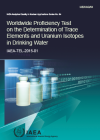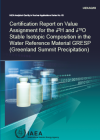The quality of water is often compromised as a result of human activities and infrastructure, making the very source of life a threat to life. Nuclear techniques can help source water quality stress factors and offer insight into how to keep water fit for purpose and remediate polluted water.
Water quality
The United Nations has recognised clean water as an essential human right. And yet, a large part of the global population must live with compromised water every day. This can mean that drinking water is unsuitable or that surface water sources are compromised – in other words, polluted rivers, lakes and oceans. This affects not just humans, but all forms of life.
Water sources can be polluted by heavy metals, complex organic compounds such as petroleum by-products or pharmaceuticals, radioactive isotopes and trace elements. The movement of these pollutants through aquatic systems depends on how water-soluble they are and how much they are able to combine with fine particles (also known as “scavenging”). In this way, some pollutants can travel great distances from their source while others are quickly bound.
Tremendous efforts are underway to improve critical water bodies. Progress has been made. The IAEA uses nuclear and isotopic tools to study the movement of pollutants in water and to measure water quality. It works with stable isotopes and radiotracers to study groundwater flow into lakes, rivers or the ocean and to better understand transport pathways of contaminants. This helps Member States avoid and mitigate pollution incidents.
The Agency also provides training on analytical techniques to improve their accuracy and detection levels. This allows for governments and decision-makers to be confident that the data on water quality they receive is reliable.
Drainage water and water quality
Pollutants from agricultural and urban run-off and drainage water from mining activities can impact water quality. In many agricultural areas, fertilisers infiltrate aquifers and contaminate the water supply. The IAEA contributes to water security by running models on water remediation times under different nitrate input scenarios. It also studies links between nutrient loadings, eutrophication (excessive nutrient levels) and the increased frequency and intensity in freshwater harmful algal bloom outbreaks.
Heightened concentrations of trace elements in groundwater have emerged as a major public health issue in many countries. This includes for example higher levels of arsenic in the groundwater.
The IAEA uses uranium isotopes 238U and 235U to assess whether uranium in water is of natural origin or emanates from the nuclear fuel cycle. IAEA researchers can also show to what extent surface water exposed to air in open storage ponds is contaminated with radionuclides. Such information was particularly relevant after the accidents that occurred in Chernobyl and Fukushima.
Ensuring the reliability of Member States' laboratories
To detect contaminants before they become a health or environmental threat, laboratories need expertise in analytical techniques that guarantee high-quality results even at trace levels. Decision-makers also need to be able to rely on data provided by the laboratories to take the appropriate decisions.
To address these issues and to help validate and reinforce the reliability of laboratories worldwide, the IAEA organises inter-laboratory comparisons and proficiency tests. These tests focus on determining whether such elements as lead, cadmium, arsenic, copper, zinc or uranium are detectable at very low concentrations in water.







